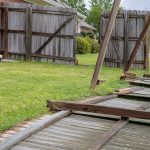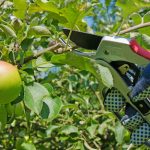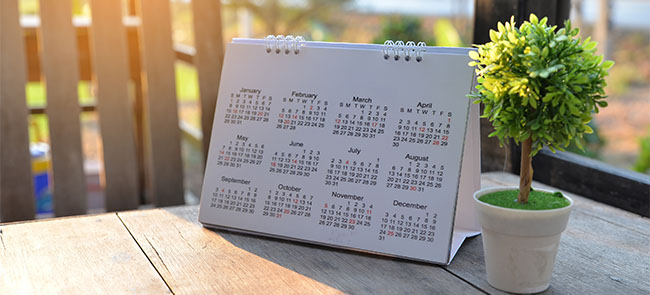
Do you love spending your free time in the garden, caring for plants, maintaining the perfect lawn, or growing your own tasty veggies? Do you wish you could be out and about, tending to your green space all year round? So do we!
The good news is, you can, and you should! Gardening is not a spring-summer activity only. Sure, it might look like nothing’s going on in the winter, but if you want a flourishing garden once spring arrives, you’ll need to give it attention in the cooler months, as well.
That’s why we have prepared this year-round gardening calendar for you!
In this post, we’ll talk about which garden tasks you can focus on each month, as well as when to plant some of the most popular vegetables.
So, if you:
- Are a gardening enthusiast;
- Are looking for tips on how to care for your garden all year round;
- Want to know what tasks you need to carry out each month,
Then read on – this seasonal gardening calendar has everything you need!
Before we get into it, please note that this gardening calendar should only be used as a general guide. Climate conditions vary across the UK, so different garden tasks may need to be done at different times, depending on where you’re located. Always pay attention to the conditions before you carry out any gardening job.
Spring gardening tips
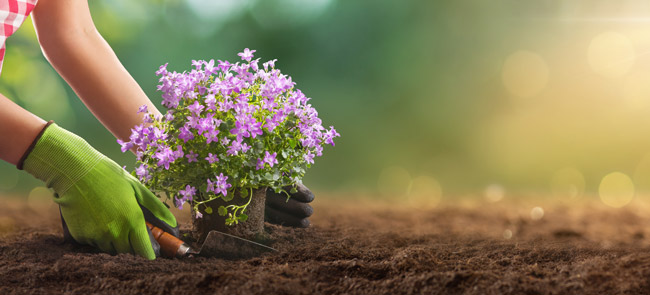
Image source: Shutterstock / Pasko Maksim
Spring is among the most beloved and most active seasons when it comes to gardening. The weather is mild, and your garden is just starting to come back to life after the winter.
While this is indeed a beautiful transformation to watch, the season comes with its fair share of spring gardening jobs you need to do to keep your green space looking its best. From planting to pruning to lawn care, you’ll need to help your garden spring back.
So, let’s go over what to do in the garden in spring, covering each month and its accompanying tasks.
Gardening jobs for March
You probably won’t feel like spring has arrived until the middle of the month or later, depending on where you live. Regardless, there are still a bunch of jobs to do in the garden in March.
This is the time to get your vegetable plots ready before you start sowing to give your veggies a good start. And that’s not all! Since you probably haven’t spent too much time outdoors during winter, you’ll need to tidy up your garden, too.
Pruning overgrown shrubs, restoring your lawn, mulching borders, and, of course, getting rid of any pesky weeds that may have taken over are all chores that need doing. There’s no shortage of gardening tasks to do in March.
What to do
- Prepare your vegetable plots for planting.
- Prune summer-flowering deciduous shrubs, perennials, and winter-flowering shrubs (after the flowers wilt).
- Fertilise plants when needed.
- Repot container plants, or topdress the pots with compost.
- Start your favourite flowering varieties indoors from seed.
- Plant summer-flowering bulbs as soon as there’s no longer a risk of frost.
- Mow the lawn when the weather allows it.
- Rake the lawn lightly to remove moss.
- Aerate the lawn if there’s no danger of frost.
- Lay a new lawn if needed.
- Deadhead flowers whenever needed.
- Apply mulch to borders and flowerbeds.
- Get rid of any weeds that appear.
- Look out for garden pests.
What veggies to plant
- Onions
- Shallots
- Garlic
- Leeks
- Spring onions
- Early potatoes
- Cabbage
- Broccoli
- Cauliflower
- Cucumbers
- Carrots
- Peppers
Keep in mind that you have to start some plants off indoors, while others can be sown directly outside. To learn more about when and where to sow different veggies, take a look at our helpful vegetable planting calendar!
Gardening jobs for April
In April, spring is in full swing. This month brings frequent showers, fast-growing seedlings, and warmer temperatures. But the danger of late frosts is still lurking around the corner.
April is a great time to start sowing outside and bringing out plants you’ve started off indoors. For any plants that are already outdoors, you’ll want to check for any frost damage that may have occurred during the colder months. You can also pay a little extra attention to your lawn, fixing any issues, repairing bare patches, and even laying a new one if you need to.
Let’s take a look at what jobs to do in the garden in April.
What to do
- Deadhead flowers whenever needed.
- Get rid of any weeds that appear.
- Look out for garden pests.
- Apply mulch to borders and flowerbeds.
- Check plants for any frost damage.
- Protect tender plants from late frost.
- Harden off indoor plants before bringing them outside.
- Stake and support tall-growing plants.
- Prune evergreens and spring-flowering shrubs, like forsythia and viburnum (after they have flowered).
- Fertilise plants when needed.
- Tend to your lawn and fix any issues.
- Overseed your lawn if necessary.
- Lay a new lawn if needed.
- Mow the lawn when the weather allows it.
- Scarify and fertilise the lawn.
What veggies to plant
- Broad beans
- Broccoli
- Cabbage
- Carrots
- Cauliflower
- Celery
- Leeks
- Peppers
- Shallots
- Spring onions
- Onions
- Tomatoes
- Cucumbers
- Radishes
Gardening jobs for May
There’s a variety of gardening jobs to do in May. With summer on the horizon, your garden will likely be growing at alarming rates. So, you’ll have to put in some extra elbow grease to keep it in check.
The time to start mowing the lawn regularly has come, too, as the grass will have sped up its growth rate due to the warmer weather. Pruning is another spring gardening task you can focus on, but there’s one extra step involved – you need to check for signs of a bird nest in the shrubbery before you cut it back.
You can sow even more plants outdoors in May, as the temperatures will only be getting warmer. For instance, you can directly sow outside some poppies, sunflowers, and tropaeolum plants, and start your favourite herbs in the greenhouse (sage, rosemary, and thyme). Late frosts can still surprise you, though, so keep an eye out and protect any tender plants. And, depending on what crops you’ve planted, you can even start harvesting some of the earlier varieties.
What to do
- Get rid of any garden weeds that appear.
- Deadhead flowers whenever needed.
- Harden off indoor plants before bringing them outside.
- Look out for garden pests.
- Ventilate greenhouses on warm days.
- Harvest early crops in the vegetable garden.
- Protect tender plants from late frost.
- Stake and support tall-growing plants.
- Train any climbing plants and tie in their new growth.
- Feed the lawn and mow when needed.
- Prune tender shrubs, evergreens, and spring-flowering shrubs. Check for nesting birds before pruning.
- Trim and shape your hedges.
- Fertilise plants when needed.
What veggies to plant
- Beans (various)
- Broccoli
- Cabbage
- Carrots
- Cauliflower
- Cucumbers
- Leeks
- Lettuce
- Peas
- Pumpkins
- Radishes
- Spinach
- Spring onions
- Sweetcorn
Summer gardening tips
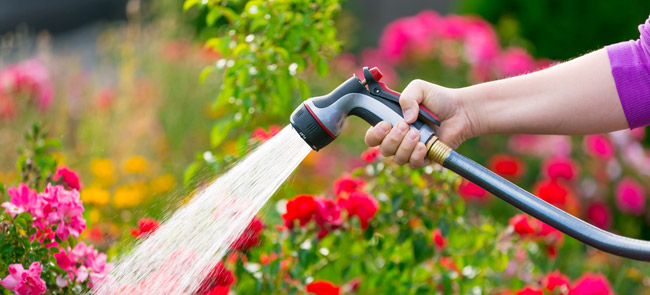
Image source: Shutterstock / topseller
Summer is here, and it comes with an abundance of garden tasks to carry out. Weeds growing left and right, colourful flowers blooming, veggies begging to be harvested, and a bunch of pests attacking. It sounds so overwhelming!
Don’t get discouraged! Sunny summer days mean you can comfortably tend to your garden and enjoy your time outdoors. And if you’ve kept your garden in good shape during spring, you’ll have an even easier time in summer!
So, let’s talk about what summer gardening jobs you can perform.
Gardening jobs for June
With the arrival of June, your garden will be growing at full throttle. Unfortunately, this includes weeds, too. This makes for an ongoing battle with these undesirables, but if you keep on top of weeding regularly, it shouldn’t cause you too much trouble.
There are a bunch of other gardening jobs to do in June, too. If you’re growing plants in a greenhouse, ventilating it often and providing some extra shade is a good way to avoid overheating and scorching. There are tonnes of veggies you can harvest in June, as well, and you can bring some extra colour to your green space by planting hanging baskets and bringing summer-flowering potted plants outside. Furthermore, you can get and plant some strawberry runners in your garden to enjoy the delicious fruit the following year.
Your plants will need a little extra water as the temperatures rise, too.
What to do
- Deadhead flowers whenever needed.
- Look out for garden pests.
- Get rid of any weeds that appear.
- Feed and mow the lawn when needed, and control weeds.
- Sow warm-season grasses.
- Ventilate greenhouses and shade them to keep them from overheating.
- Plant and bring out summer hanging baskets.
- Harvest ready crops.
- Stake and support tall-growing plants.
- Move any summer-flowering plants outdoors.
- Start increasing how much you water plants.
- Prune tender shrubs and hardy fuchsias, and evergreens.
- Fertilise plants when needed.
What veggies to plant
- Beans
- Beetroot
- Cabbage
- Cauliflower
- Courgettes
- Cucumbers
- Lettuce
- Peas
- Pumpkins
- Radishes
- Spinach
- Spring onions
Gardening jobs for July
July comes with regular deadheading, lots of watering, and a war on weeds (yes, that’s still going on). The good news is that you can soak up the abundant sunshine while tending to your garden.
Among the numerous gardening jobs for July, lawn care is one that you need to pay some extra attention to. In prolonged periods of dry, hot weather, cutting the grass is not recommended. If you need to mow the lawn, raise the height of the cut to the highest level.
Keep on top of watering, as the high temperatures can make the soil dry out faster.
You can give garden structures some tender loving care, too. If you need to repair and paint a fence or shed, now is a good time to do so.
What to do
- Deadhead flowers whenever needed.
- Look out for garden pests.
- Get rid of any weeds that appear.
- Harvest ready crops.
- Feed and mow the lawn when needed. If it’s too hot and dry, avoid mowing or raise the height as much as possible.
- Keep an eye out for plant and lawn diseases.
- Increase how much you water plants.
- Take care of your garden structures and equipment – fences, sheds, tools, ponds, etc.
- Prune summer-flowering shrubs (after they’ve finished flowering).
- Fertilise plants when needed.
What veggies to plant
- Beans
- Cabbage
- Leeks
- Lettuce
- Radishes
- Spinach
- Spring onions
- Swedes
Garden jobs for August
You can carry over any tasks you’ve done in July if you’re wondering what to do in the garden in August. Regular weeding, frequent watering, careful mowing, and veggie harvesting are among the jobs you can focus on. You can start gathering seeds from your plants in August, too.
What to do
- Deadhead flowers whenever needed.
- Look out for garden pests.
- Get rid of any weeds that appear.
- Keep an eye out for plant diseases.
- Harvest ready crops.
- Feed and mow the lawn when needed. If it’s too hot and dry, avoid mowing or raise the height as much as possible.
- Increase how much you water plants.
- Start collecting seeds and seed pods from your plants.
- Prune shrubs (after flowering) and hedges.
- Fertilise plants when needed.
What veggies to plant
- Beetroot
- Cabbage
- Lettuce
- Onions
- Radishes
- Spinach
- Spring onions
- Strawberries
Don’t want to spend all day in the heat?
Find an expert gardener to do all the hard work instead!

Autumn gardening tips
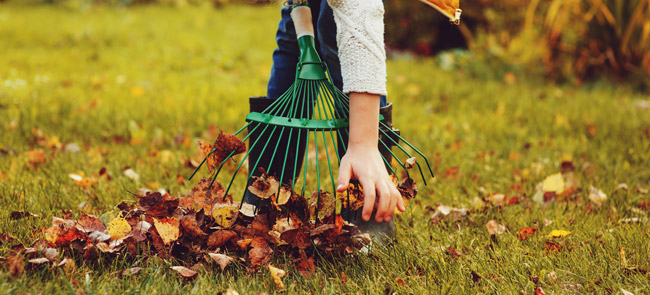
Image source: Shutterstock / Maria Evseyeva
It’s starting to get colder outside, but that doesn’t mean you should start ignoring your green space! There are lots of autumn gardening jobs to be done to prepare your garden for the colder seasons.
During autumn, you’ll be harvesting a lot. And don’t get us started on leaf clearance! Rest assured, the amount of work you can do in your garden in autumn has not dropped.
So, here are some monthly gardening tips for autumn to keep in mind.
Garden jobs for September
There are a bunch of veggies that will be ready for harvesting in September, depending on what you’ve sown, of course. Planting spring-flowering plants during this month is also a good way to ensure a colourful display once the warmer seasons arrive.
Some other jobs to do in the garden in September are clearing fallen leaves, gathering seeds, and, of course, weeding. You might have picked up on this already, but yes, weeding is a year-round gardening task. Think about protecting tender plants from the upcoming frost, as well.
September is a great time to provide extra lawn care, too, such as aerating and fixing bare patches. Alternatively, if you’re thinking of laying new turf, now is the perfect time to do it.
You can start tidying up your greenhouses and cold frames, too.
What to do
- Deadhead flowers whenever needed.
- Look out for garden pests.
- Get rid of any weeds that appear.
- Clear any fallen leaves.
- Keep collecting seeds and seed pods from your plants.
- Keep an eye out for plant diseases.
- Harvest ready crops.
- Clean out cold frames and greenhouses and tidy them up.
- Reduce watering.
- Protect tender plants and overwinter the ones you like.
- Aerate, rake, and fertilise your lawn. Mow when needed.
- If there are bare or damaged patches, sow new grass seed.
- Lay new turf if needed.
- Prune evergreens for the last time before winter.
- Plant hardy annual cool-season bloomers, spring-flowering bulbs, and various perennial plants.
What veggies to plant
- Lettuce
- Radishes
- Spring onions
Gardening jobs for October
Autumn is now here, and you can really feel the cold. Just like the previous month, you can keep weeding and clearing away leaves to keep your green space tidy.
Some garden jobs for October to pay attention to are transplanting any plants that need it, protecting plants from frost, and harvesting. Keep deadheading fading flowers, but try to do it when the temperatures are milder. You can also still lay new turf until about mid-October, depending on the weather in your area.
What to do
- Apply mulch/compost to borders if you haven’t done it in spring.
- Deadhead flowers whenever needed and if the weather is not too harsh.
- Get rid of any weeds that appear.
- Clear any fallen leaves.
- Look out for garden pests.
- Transplant any plants that need it.
- Protect your plants from frost (especially tender ones).
- Harvest ready crops.
- Fertilise, weed, and mow the lawn.
- Keep collecting seeds and seed pods from your plants.
- Lay new turf if needed.
- Keep an eye out for plant diseases.
- Prune deciduous hedges.
- You can also plant your favourite fruit shrubs and plants – currants, gooseberries, cranberries, grapevines.
What veggies to plant
- Garlic
- Lettuce
- Radishes
- Rhubarb
- Spring onions
- Peas
Gardening jobs for November
As winter approaches, one of the most important garden jobs for November is protecting plants from frost and strong winds. Whether you wrap your pots or move your plants into a greenhouse is up to you.
November is a good time to provide some final lawn care, too, as this will be your last chance to cut the grass. In other words, it’s important to winterise your garden properly before the cold weather sets in.
In addition to raking away fallen leaves, you’ll also want to clear any dead plants. And, of course, keep on weeding!
What to do
- Scarify the lawn and mow it for the last time before the frost sets in.
- Clear any fallen leaves.
- Protect your plants from frost (especially tender ones).
- Harvest ready crops.
- Clear away any dead plants.
- Apply mulch to borders.
- Get rid of any weeds that appear.
- Keep an eye out for plant diseases.
- Prune deciduous shrubs and hedges. You can trim shrubs you’d usually prune in spring, but only cut them back halfway. Avoid trimming evergreens and tender plants.
- November is a good time for planting fruit trees and shrubs (blackberries and raspberries).
What veggies to plant
- Broad beans
- Garlic
- Peas
- Rhubarb
- Lettuce
- Onions
Winter gardening tips
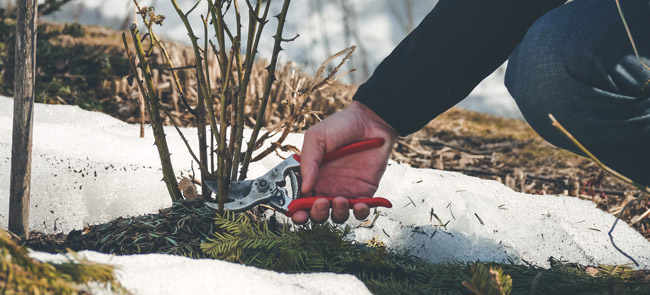
Image source: Shutterstock / Floki
Winter is an excellent time to cool down (pun intended) and take a break from back-breaking garden work. That doesn’t mean you can forget about it completely, though! There are still some winter gardening jobs to be done.
From protecting plants from chilly weather to generally tidying up, you can always find things to do in the garden in winter. And there’s one super fun task that you don’t even have to leave your couch to do. That’s right – planning your garden! From crop rotation to flowerbed design, you can let your inner landscaper out!
Avoid walking on your lawn in winter, especially if it’s waterlogged or frosted over, as that can damage it severely. There isn’t that much lawn care to provide in winter, so keeping off the grass shouldn’t be too difficult.
Gardening jobs for December
If you’re wondering what to do in the garden in December, the answer is simple – tidy up! Borders, weeds, anything that needs clearing, really. You might have some veggies left in your garden that are just about ready to be gathered, too, so harvest them before the cold gets to them.
December can bring snow, too. So, if you want to prevent frost damage on your shrubs and hedges, shake any snow off of them regularly.
Apart from protecting your plants from winter frost, you might also want to insulate any outdoor taps and pipes. Frozen pipes can cause all sorts of problems, so your best bet is to prevent them from freezing in the first place.
What to do
- Tidy up the borders.
- Keep an eye out for plant diseases.
- Shake any snow off shrubs and hedges to prevent frost damage.
- Harvest ready crops.
- Insulate any outdoor taps and pipes to prevent freezing.
- You can ventilate greenhouses on warmer days. Check that heaters are working.
- Protect your plants from frost (especially tender ones).
- Clear any fallen leaves and other debris.
- Look out for garden pests.
- Get rid of any weeds that appear.
- Reduce how much you water plants.
- Prune deciduous shrubs and hedges. Avoid trimming evergreens and tender plants.
What veggies to plant
- Broad beans
- Lettuce
- Onions
Gardening jobs for January
In January, you can carry on planning out your veggie plots. Tidying and cleaning up greenhouses and plant pots is also a good place to start if you don’t know what to do in the garden in January.
Keep paying attention to your shrubs and hedges, shaking any snow off them. Make sure the frost won’t get to your tender plants, too.
January is the perfect time to take care of your garden tools, too. You have more time to sharpen and clean them, as well as check for any damage or malfunctions.
What to do
- Clean and tidy up your greenhouse. Ventilate them on warmer days. Clean up plant pots, as well.
- Plan out your vegetable garden for the coming season.
- Shake any snow off shrubs and hedges to prevent frost damage.
- Protect your plants from frost (especially tender ones).
- Look out for garden pests.
- Get rid of any weeds that appear.
- Harvest ready crops.
- Take care of your garden tools – clean and sharpen them, check for damage.
- Keep an eye out for plant diseases.
- Fertilise plants when needed.
- Start chitting potatoes.
- Prune deciduous shrubs and hedges. Avoid trimming evergreens and tender plants.
- You can keep on planting some fruit-bearing plants (trees and shrubs).
What veggies to plant
- Broad beans
- Peas
- Cabbage
- Cauliflower
- Leeks
- Lettuce
- Onions
- Tomatoes
Gardening jobs for February
The number of February jobs in the garden is significantly lower, but there are still some tasks to take care of.
February can bring a bountiful harvest if you’ve sown the right veggies earlier in the year, so one of the things you can spend your time on is gathering them.
Naturally, you should keep protecting your tender plants from frost damage and shaking snow off hedges. Some weeds are still going strong, so keep an eye out and get rid of them when they appear.
What to do
- Protect your plants from frost (especially tender ones).
- Get rid of any weeds that appear.
- Keep an eye out for plant diseases.
- Shake any snow off shrubs and hedges to prevent frost damage.
- Harvest ready crops.
- Chit potatoes.
- Fertilise winter-flowering plants when needed.
What veggies to plant
- Broad beans
- Carrots
- Peas
- Broccoli
- Cabbage
- Cauliflower
- Cucumbers
- Leeks
- Lettuce
- Onions
- Peppers
- Tomatoes
Feeling overwhelmed? Get help from the experts!
If you want a thriving garden but don’t fancy all the manual labour that comes with it, why not turn to the professionals? Fantastic Services offers a wide range of gardening services, from garden maintenance to lawn care. The experienced gardeners we work with come equipped with all the tools they need and are ready to turn your green space into a slice of heaven!
Leave all the hard work to the experts and enjoy your lush garden and extra free time!
Need a Gardener?
Find a professional to make your garden flourish!

Takeaways
- Spring is a great time to start sowing and help your garden come back to life.
- Provide extra care for your lawn from spring through autumn.
- Increase the watering frequency, as the soil will dry out faster in hot weather. Water less often in winter.
- Weeding, pest control, and looking out for diseases should be carried out throughout the whole year.
- Most crops become ready for harvesting in autumn.
- Protect your plants from frost in the colder seasons, including the start of spring.
- Winter is the perfect season to plan out next year’s veggie garden.
***
We hope you found our year-round gardening calendar helpful. If you have any questions, don’t hesitate to share them in the comments below. Happy gardening!
Image source: Shutterstock / Pra Chid




